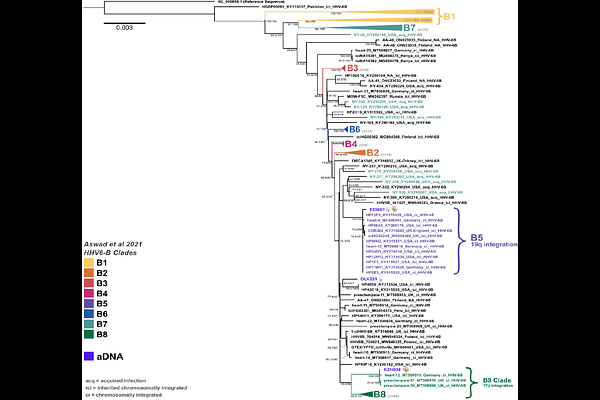2500 Years of Human Betaherpesvirus 6A and 6B Evolution Revealed by Ancient DNA

2500 Years of Human Betaherpesvirus 6A and 6B Evolution Revealed by Ancient DNA
Guellil, M.; van Dorp, L.; Saag, L.; Beneker, O.; Bonucci, B.; Sasso, S.; Saupe, T.; Solnik, A.; Kabral, H.; Allmäe, R.; Bates, J.; Dittmar, J. M.; Ge, X. J.; Inskip, S.; Jonuks, T.; Karmanov, V. N.; Khartanovich, V. I.; Larmuseau, M. H. D.; Aneli, S.; Cessford, C.; Kriiska, A.; Mägi, M.; Malve, M.; De Winter, N.; Metspalu, M.; Pagani, L.; Robb, J. E.; Kivisild, T.; Houldcroft, C. J.; Scheib, C. L.; Tambets, K.
AbstractHuman betaherpesviruses 6A and 6B are double-stranded DNA viruses, specialised in infecting humans and are best known as the main causative pathogens of the common childhood infection \'sixth disease\'. Despite only being discovered in the 1980s, these viruses are speculated to have a much longer and more complex history within the human population than available modern data make clear. The viruses are carried by large fractions of the human population and can integrate into the human genome, leading to a wide range of clinical manifestations of varied severity. Here, we present the first nine full and two partial ancient genomes of HHV-6A and 6B, dating as far back as the Italian Iron Age (ca. 1100-600 BCE). We demonstrate that large fractions of the current HHV-6 diversity were already well established in the human population by the 14th century CE. Our data suggests that HHV-6B integrated into the human genome at the latest before the 1st-6th century CE, with two integrated clades being populated by ancient DNA genomes in our phylogeny, which further supports that they originated from likely much older ancient founder events. Additionally, we show that all known inherited chromosomally integrated (ici-)HHV-6A clades were already represented in European historical populations, confirming that ici-HHV-6A no longer integrates into the human germline within populations of European ancestry and likely endogenized in early human history. Finally, our results demonstrate the unique suitability of archaeological remains and ancient DNA for the study of the evolution of integrated viruses in human populations.